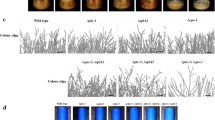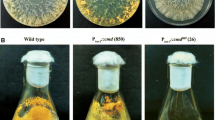Abstract.
A new clock mutant (rhy-2) was isolated by DNA insertion mutagenesis using a plasmid that contains a region located upstream of the cmd gene in the genome of Neurospora crassa. This mutant is arrhythmic with regard to conidiation in continuous darkness but rhythmic under a light-dark cycle. After plasmid rescue from genomic DNA of the rhy-2 strain, the insertion was localized to the gene white collar-1 (wc-1). Plasmid DNA was inserted 3′ to the sequence encoding the polyglutamine region of the WC-1 gene product, and an mRNA encoding a truncated WC-1 protein must be synthesized under the control of the cmd promoter. The new wc-1 mutant, rhy-2, is still sensitive to light, although only weakly. Since the circadian rhythm of conidiation in continuous darkness is eliminated in the mutant, the polyglutamine region in WC-1 may be essential for both clock function and light-induced carotenogenesis in Neurospora.
Similar content being viewed by others
Author information
Authors and Affiliations
Additional information
Electronic Publication
Rights and permissions
About this article
Cite this article
Toyota, K., Onai, K. & Nakashima, H. A new wc-1 mutant of Neurospora crassa shows unique light sensitivity in the circadian conidiation rhythm. Mol Gen Genomics 268, 56–61 (2002). https://doi.org/10.1007/s00438-002-0722-1
Received:
Accepted:
Issue Date:
DOI: https://doi.org/10.1007/s00438-002-0722-1




